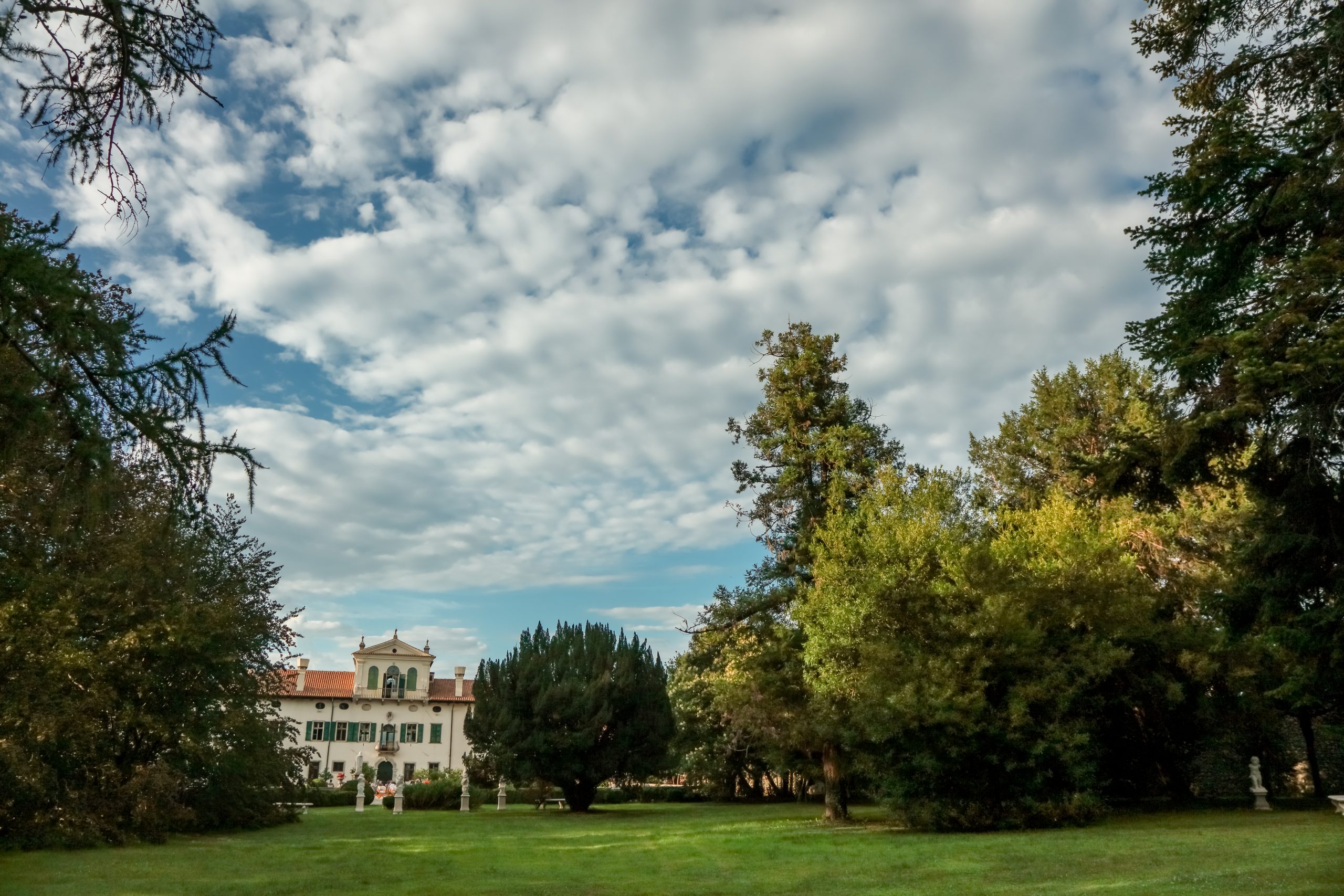The English garden

Sophisticated spontaneity
The English garden, also known as the park, is one of the most fascinating and evocative spaces at Villa de Claricini Dornpacher.
Created during the 18th century, the English garden model is distinguished by its use of the concept of the ‘picturesque’, which rejects the rigidity of formal gardens, such as those in the Italian and French styles, to embrace a more natural and informal vision.
In contrast to geometric gardens, the basic idea of the English garden is to evoke a landscape that seems spontaneous; the arrangement of plants is no longer designed to define and delimit space, but to create a succession of glimpses and views that the walker gradually discovers, without ever having a complete overview.
The English garden developed in the villa in Bottenicco fully reflects the characteristics of this type of garden: the use of century-old trees, shrubs and native plants that create a landscape that, while giving the impression of being wild, is always meticulously cared for. This garden does not seek symmetry, but rather plays with the alternation of wide views and more intimate corners, where nature appears as a natural but studied landscape.
The transition from one garden to another
The transition from the Italian garden to the English garden is marked by a distinctive feature: boxwood hedges arranged in a semicircle and statues of the Four Seasons. This symbolic boundary marks the transition between two worlds of gardening, one formal and the other freer and more natural. The presence of these statues, representing the seasons, suggests the cycle of nature, which in the English garden is expressed in all its vitality and change. Once this boundary has been crossed, the 17,500 m² park opens up before the visitor’s eyes, seemingly spontaneous but with attention to detail, in stark contrast to the rigidity of the Italian-style garden.
The new challenges
The English garden has been one of the spaces most affected by climate change in recent decades. Tall trees, such as poplars, beeches, cedars, and holm oaks, which once populated the park, suffered from long droughts and intense storms between 2017 and 2021, as well as wood rot that damaged many specimens. However, through careful restoration and redevelopment, the park is regaining its vitality.
New irrigation systems have been introduced and numerous trees have been planted in accordance with those in the historical records of the Claricini Dornpacher family. Plants such as Japanese Yew (Cephalotaxus harringtonii), Japanese Cypress (Cryptomeria elegans), California Cedar (Calocedrus decurrens), Photinia (Photinia serrulata), Holm Oak (Quercus ilex) and Pseudotsuga (Pseudotsuga), all already documented in the historical purchases of 1910, have been reintroduced to keep the character of the garden intact. In addition, new specimens, such as Tulip Tree (Liriodendron tulipifera) and Sophora pendula japonica (Sophora japonica pendula), have been planted to replace some centuries-old plants now unsuited to current climatic conditions. In addition, new specimens, such as Tulip Tree (Liriodendron tulipifera) and Sophora pendula japonica (Sophora japonica pendula), have been planted to replace some centuries-old plants now unsuited to current climatic conditions.
Accessibility and hydrangeas
Visitors can admire here some of the approximately 40 existing species of hydrangeas. These flowering plants, whose seeds are enveloped by a fruit, are easily recognized by their flowers grouped in corymb-shaped inflorescences or panicles. Many of the flowers are sterile, that is, they do not produce seeds or fruit; in particular, the outermost flowers have replaced petals
Among the most interesting varieties in the park are worth mentioning:
The Large-leaved Hydrangea (Hydrangea macrophylla), native to Japan and introduced to Europe in the 17th century. This hydrangea is distinguished by its inflorescences that vary from blue to white to dark pink, depending on soil composition. Blue color develops in acidic soils, where aluminum ions are easily absorbed by the roots, while pink is obtained in soils with higher concentrations of calcium ions or other elements that hinder aluminum absorption.
Hydrangea serrata (Hydrangea serrata), similar to the large-leaved Hydrangea but smaller in size, comes from the mountainous areas of Japan and Korea. Also known as Mountain Hydrangea, this plant is prized for its flowers that vary from pink to blue, depending on soil pH. Its oval, serrated leaves give it a distinctive appearance, hence the name “serrata.” Hardy and adaptable to various climates, this hydrangea prefers partial shade and well-drained soil.
The Hydrangea (Hydrangea arborescens)the variety that pioneered hydrangeas in European gardens, is the first to bloom of all species. Its flowers, either snow-white or soft pink, bloom in mid-June and continue to maintain their beauty until the cold season begins.
The English garden of the Bottenicco villa is a perfect example of how nature and the art of gardening can merge to create a space that is both a refuge and a form of aesthetic expression.
Between the centuries-old plants, architectural elements, and recent redevelopments, this garden continues to be a place of beauty and serenity, combining the traditions of the past with the needs of the present.
